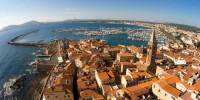The City

The
city’s boundaries extend well into the flatlands of the Nurra. At
the city’s western edge, you cannot fail to be struck by the
carbonate formations of the karst system of Capo Caccia, Punta Giglio
and Monte Doglia. To the south, the territory is constituted mainly
by the vulcanitic rocks of the reliefs that form the immense plateau
of Villanova Monteleone and Bosa. Various watercourses run downwards
from Bosa, crossing the fertile plain. These have enabled the
presence of human communities since time immemorial. The city is
surrounded for miles in every direction by dense olive groves and
vineyards, and at one time the fruits of these fields constituted the
mainstay of the local economy.
The
Climate
The
warm- temperate, sub-tropical climate features long, dry summers and
mild, damp winters. The main winds blow from the western quadrants:
the trade winds mitigate the summer heat; from autumn to spring, the
west wind and the south-west wind cause the heaviest downpours,
whereas the north-west wind can blow rather impetuously in any
season.
For
a few weeks between December and February, the eastern currents help
to produce clear weather, with cold nights and sunny days, which are
called the "secche di gennaio" (the January dry spell) and
are almost a prelude to summer, right in the middle of winter.
For
more information, visit the Official Site of Alghero
City Council








